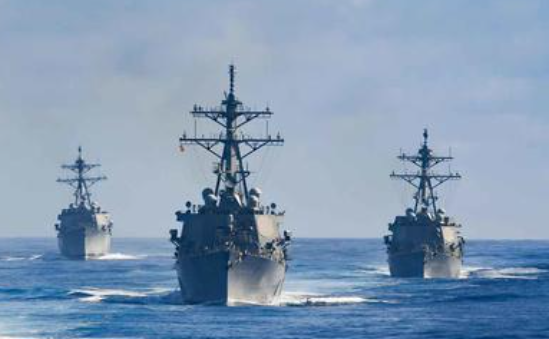The United States Navy is currently grappling with a severe shortage of personnel to man its support and replacement vessels, according to a report by the U.S. Naval Institute News. This staffing crisis is partly attributed to the COVID-19 vaccine mandates, which reportedly led to the loss of many servicemen during the pandemic, either through death or departure.
To address this issue, the Navy is considering a plan to place 17 support and replenishment ships into “extended maintenance,” effectively sidelining them. This move would reallocate their crews—roughly 600 to 700 sailors—to more critical roles on combat ships, aligning with the military’s immediate needs and the demands of ongoing conflicts.
The U.S. Navy may write off ships due to a shortage of 4,500 personnel
17 auxiliary ships engaged in supply and refueling are going to be decommissioned. They are planned to be sent for “long-term maintenance”, which will allow to redistribute up to 700 sailors to other ships.… pic.twitter.com/qC7sHuLfGP
— ☦️Jacob🇷🇺Charite☦️ Иагов (@jaccocharite) August 26, 2024
The Navy’s struggle to find enough qualified mariners has created a significant problem, particularly as the U.S. military ramps up its presence in the Middle East to support Israel amid escalating regional tensions. Under the Military Sealift Command’s “force generation reset,” the plan involves placing two Lewis and Clark-class replenishment ships, one fleet oiler, 12 Spearhead-class Expeditionary Fast Transports, and two forward-deployed Navy expeditionary sea bases into “extended maintenance.” This move is intended to free up personnel for more urgent duties.
This proposal, ominously dubbed “the great reset,” is still awaiting formal approval from the Chief of Naval Operations, Admiral Lisa Franchetti. Franchetti, who holds a Bachelor’s degree in Journalism from Northwestern University and a Master’s degree in Organizational Management from the University of Phoenix, has yet to make a final decision.
The US Navy is facing an manpower shortage. The Merchant Marines was forced to sideline 17 support ships because it could not properly crew and operate ships. pic.twitter.com/TAOiB1vORH
— Jake H (@jake22_h) August 26, 2024
Retired MSC commander Rear Admiral Michael Wettlaufer, who was instrumental in implementing stringent COVID-19 prevention measures, is believed to have significantly contributed to the Navy’s current retention problems. During the pandemic, restrictive policies meant that sailors were often confined to their ships, leading to dissatisfaction and a surge in resignations. “Nobody was allowed to leave the ship during COVID, and mariners were treated poorly, so they began to leave in droves,” a retired MSC mariner recounted.
This exodus has continued, with mariners quitting at a rate faster than new hires can replace them. Many cite the untenable work-life balance as a major reason for leaving. One former mariner explained, “I had to leave because maintaining a family life while going to sea was impossible.”
Another former mariner shared that although he enjoyed his time at sea with MSC, he decided to quit after observing the toll the lifestyle took on older colleagues, many of whom faced family strife due to prolonged absences. “When I left, it was because I realized the importance of being with my family,” he said.
🇺🇸⚓️ U.S. Navy to Sideline 17 Ships Amid Growing “Manpower Shortage”
The U.S. Navy has announced plans to sideline 17 vessels, citing a significant shortage of personnel required to operate and maintain the fleet effectively. pic.twitter.com/vQlQlauIxb
— DD Geopolitics (@DD_Geopolitics) August 24, 2024
Sal Mercogliano, a former MSC mariner and now an associate professor of history at Campbell University, noted that the Navy’s retention issues are the culmination of years of mismanagement. “They are burning through personnel,” he commented, highlighting a long-standing neglect of the workforce.
The staffing model currently in place is unsustainable, with only about 1.27 mariners available for every billet on an MSC ship. This ratio means mariners are at sea for four months with only one month of leave, making it nearly impossible to maintain a healthy work-life balance. “The math just doesn’t add up,” a former mariner pointed out.
He emphasized that the current structure does not allow enough time for sailors to rest, spend time with family, or even fulfill medical and training requirements. “There is so much training required to keep up with Navy demands and maintain merchant marine credentials that there’s little room left for personal life,” he added.
This unsustainable cycle continues to push mariners away, compounding the Navy’s staffing woes and forcing it to reconsider its current operational strategy.
Major Points
- The U.S. Navy is experiencing a critical shortage of personnel to operate its support and replenishment ships, exacerbated by COVID-19 vaccine mandates and subsequent resignations.
- To address this shortage, the Navy is considering placing 17 support ships in “extended maintenance” to reallocate approximately 600-700 sailors to more crucial combat roles.
- The proposal, known as “the great reset,” awaits approval from Admiral Lisa Franchetti, the Chief of Naval Operations.
- The Navy’s staffing crisis stems from high turnover rates among mariners, who have left due to poor work-life balance and restrictive policies during the pandemic.
- The current staffing model is unsustainable, with inadequate personnel leading to extended sea deployments and insufficient leave, further driving mariners away.
RM Tomi – Reprinted with permission of Whatfinger News



